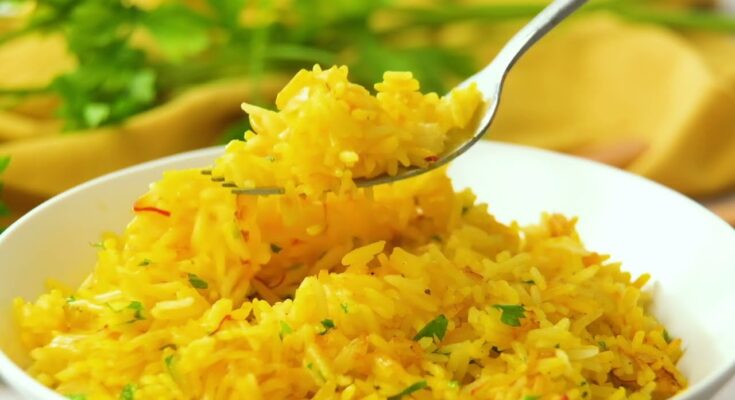Saffron Rice Recipe: Saffron rice is not just a side dish—it’s an experience. With its luxurious golden hue and aromatic flair, saffron rice turns even the simplest meal into something memorable. Loved across continents from the Middle East to South Asia, this dish is steeped in tradition and is a staple at festive occasions, weddings, and elegant dinners. What sets it apart? That unmistakable scent of saffron—earthy, floral, and slightly sweet—infused into each fluffy grain of rice.
But what’s truly magical is how a small pinch of saffron can completely transform a plain bowl of rice. The threads are delicate and potent, making saffron one of the most expensive spices in the world, ounce for ounce. Yet, you only need a tiny bit to make a big impact. Whether you’re making Persian tahdig, Indian biryani, or just jazzing up a weeknight meal, saffron rice brings richness and elegance to the table. This guide breaks down the recipe step by step, so even a kitchen newbie can whip up the perfect saffron rice.
Ingredients Needed for Saffron Rice
Let’s talk ingredients. The beauty of saffron rice lies in its simplicity—you don’t need a long list of fancy items, just a few quality ones. Here’s everything you’ll need:
Main Ingredients:
- Basmati rice – 1 cup (long-grain is best for fluffiness)
- Saffron threads – a generous pinch (around 15-20 strands)
- Hot water or milk – 2 tablespoons (to steep the saffron)
- Butter or ghee – 1 to 2 tablespoons (for richness)
- Salt – to taste
- Optional add-ons: sliced almonds, raisins, cardamom pods, bay leaf
How to Choose Quality Saffron:
Not all saffron is created equal. The best saffron comes in whole threads, not powdered form. Look for deep red strands with slightly orange tips. They should smell fragrant and a bit sweet. If the saffron is dull in color or lacks aroma, it’s likely of lower quality or even fake.
Pro Tip: Store saffron in an airtight container, away from sunlight and heat. It can last up to two years this way.
The ingredient list might be short, but each element has a role to play. The rice must be fluffy, the saffron aromatic, and the fat (butter or ghee) adds that silky finish that ties everything together. Keep reading for the detailed cooking process!
Step-by-Step Guide to Cooking Saffron Rice
Making saffron rice isn’t complicated, but a few precise steps ensure you get restaurant-quality results. Let’s break it down:
Step 1: Soaking the Rice
Rinse 1 cup of basmati rice under cold water 2-3 times until the water runs clear. This removes excess starch that makes rice sticky.
After rinsing, soak the rice in clean water for about 30 minutes. This step allows the grains to expand fully during cooking, giving you that light, fluffy texture. While the rice soaks, move on to the next step—preparing the saffron infusion.
Pro Tip: Don’t skip the rinse-and-soak process unless you want clumpy rice!
Step 2: Preparing the Saffron Infusion
Take a generous pinch of saffron threads (about 15-20 strands) and place them in a small bowl. Add 2 tablespoons of hot water or warm milk—just hot enough to release the flavor but not boiling. Let the saffron steep for 10-15 minutes. You’ll notice the liquid turning a vibrant orange-yellow. That’s saffron’s magic at work.
If you want to maximize the flavor, you can lightly crush the saffron threads with the back of a spoon before adding the liquid. This helps release more aroma and color.
Note: Using milk instead of water adds a richer texture, while water keeps it lighter—choose based on your preference.
Step 3: Cooking the Rice
After the soaking time is up, drain the rice. In a medium pot, bring 2 cups of water to a boil. Add a pinch of salt and 1 tablespoon of butter or ghee.
Once the water is boiling, add the drained rice. Stir gently to prevent sticking. Reduce the heat to low, cover the pot, and let it simmer for 12-15 minutes. Do not open the lid during this time—steam is your friend here.
After 15 minutes, turn off the heat and let the rice sit covered for another 5-10 minutes. This resting time allows the grains to firm up without getting mushy.
Step 4: Adding the Saffron Infusion
Once your rice is steamed and resting, it’s time to add the golden touch. Gently fluff the rice with a fork—never stir aggressively or you’ll break the grains. Then, evenly drizzle the saffron infusion over the top. Don’t mix it all the way in yet. Let the saffron sink in naturally and color parts of the rice for that beautiful marbled effect.
You’ll see pockets of gold and white—this contrast looks amazing when served. Cover the pot again and let it sit for 5 more minutes. This allows the saffron aroma to deeply penetrate the rice without overcooking it.
Want a deeper color? Add a bit more saffron or steep it longer before adding. Want a subtle scent? Use less or dilute it more.
Optional Tip: For a rich Persian-style effect, you can create a crispy bottom layer known as “tahdig” by letting the rice sit over low heat for another 10 minutes with a bit of extra oil at the bottom.
Step 5: Final Touch and Resting Time
You’re almost there! Once the saffron infusion is absorbed and the rice has rested, give it one final fluff with a fork. At this point, you can add garnishes if you like:
- Toasted almonds or pine nuts for crunch
- Golden raisins or dried cranberries for a sweet contrast
- Fresh herbs like parsley or cilantro for a green pop
The goal is to keep it light and let the saffron shine through. Too many extras can overpower the delicacy of the spice.
Let the finished rice sit uncovered for just a couple of minutes before serving. This helps any extra moisture evaporate, leaving each grain perfectly separate and fluffy.
Now you’re ready to serve your saffron rice—and trust me, it’s going to be a showstopper on any table!
Pro Tips for Perfect Saffron Rice
Even the best cooks make mistakes, but saffron rice is one dish where a little attention to detail pays off big. Here are some expert tips to make sure your rice turns out flawless every time:
1. Use Good Quality Saffron
Low-grade saffron or fake products won’t give you that rich aroma or golden color. Invest in high-quality, whole saffron threads for the best result. A small amount goes a long way, so it’s worth the price.
2. Don’t Skip the Soaking
Skipping the rinse and soak step may seem like a shortcut, but it will cost you in texture. Soaking softens the rice and helps the grains cook evenly and stay separate.
3. Infuse Saffron Properly
Never throw saffron directly into the pot—always steep it in hot water or milk first. This step extracts the maximum color and fragrance, which is what makes saffron rice special.
4. Be Gentle with the Rice
After cooking, handle the rice like you would a newborn kitten—gently. Use a fork to fluff, not a spoon to stir. This keeps the grains intact and prevents clumping.
5. Rest Before Serving
That final resting time after cooking lets the rice absorb all the flavors and settle into the perfect texture. Don’t rush it!
Bonus Tip: Make a double batch! Saffron rice reheats beautifully and tastes even better the next day. Just add a splash of water before microwaving to keep it moist.
Serving Suggestions for Saffron Rice
Saffron rice is as versatile as it is beautiful. It pairs well with a wide range of dishes, from meat-heavy mains to veggie-forward fare. Here are some delicious ideas:
Perfect Pairings:
- Lamb or chicken curry: The richness of curry balances beautifully with the floral notes of saffron.
- Grilled seafood: Try it with grilled shrimp or salmon for a Mediterranean vibe.
- Roasted vegetables: A great option for vegetarians. Think roasted carrots, cauliflower, and zucchini.
- Koftas or kebabs: The spices in the meat complement saffron’s subtle aroma.
- Persian stews (like Ghormeh Sabzi): A traditional match made in heaven.
Presentation Ideas:
- Mold the rice into a bowl and invert it onto a plate for a dome shape.
- Sprinkle pomegranate seeds or herbs on top for color.
- Serve it in a decorative bowl with gold-toned utensils for a regal touch.
Occasions to Serve:
- Festive dinners and holidays
- Dinner parties and potlucks
- As a luxurious side on a regular weekday
No matter how you serve it, saffron rice adds an elegant flair that turns any meal into a celebration.
Variations of Saffron Rice Across Cultures
One of the most fascinating things about saffron rice is how it appears in different forms around the world. While the base concept remains the same—rice infused with saffron—each culture brings its own spin.
1. Persian Saffron Rice (Tahdig Style)
In Persian cuisine, saffron rice is often paired with a crispy golden crust called tahdig. Made by letting the bottom layer of the rice brown in the pot, tahdig is a highly prized delicacy. Some even layer the rice with thin potato or flatbread slices for extra crunch. It’s typically served with stews like Fesenjan or Ghormeh Sabzi.
2. Indian Saffron Rice (Zafrani Pulao)
In Indian cooking, saffron rice often appears as Zafrani Pulao—a rich, sweet-savory rice dish made with ghee, cashews, raisins, and aromatic spices like cardamom and cinnamon. It’s often served at weddings and special occasions and sometimes even includes paneer or vegetables for added richness.
3. Spanish Saffron Rice (Arroz con Azafrán)
Saffron is a key ingredient in Spanish paella, but you’ll also find simpler versions of saffron rice like arroz con azafrán served with seafood or chicken. Spanish versions often use short-grain rice like Bomba and are cooked in a wide, shallow pan for a slightly crispy bottom.
4. Middle Eastern Saffron Rice
In countries like Lebanon, Iran, and Iraq, saffron rice often accompanies lamb dishes and is sometimes topped with slivered almonds and caramelized onions. The flavor profile is often subtler, letting the natural fragrance of saffron dominate.
No matter where you are, saffron rice tells a story—of trade routes, ancient traditions, and the universal love for flavor and color on a plate.
Health Benefits of Saffron Rice
Besides being stunning and flavorful, saffron rice also has some impressive health perks. Here’s what makes it more than just a pretty side dish:
1. Rich in Antioxidants
Saffron contains compounds like crocin, crocetin, and safranal, all known for their antioxidant properties. These help neutralize harmful free radicals in the body, potentially reducing inflammation and protecting cells from damage.
2. Mood Enhancer
Saffron has been studied for its potential to boost mood and reduce symptoms of depression. It’s sometimes called the “sunshine spice” not just for its color but its potential mental health benefits.
3. Supports Heart Health
The antioxidants in saffron may improve heart health by lowering blood pressure and reducing cholesterol. Combined with basmati rice, which has a low glycemic index, it can be a heart-friendly meal when eaten in moderation.
4. Digestive Benefits
Rice is easy to digest, and saffron has traditionally been used in herbal medicine to aid digestion and soothe the stomach. The combination is gentle yet nourishing, making saffron rice a good option for sensitive stomachs.
Note: As with any rich dish, moderation is key—especially if you’re watching your calorie intake.
Storage and Reheating Tips
Saffron rice isn’t just a one-meal wonder. It stores and reheats beautifully if you follow a few simple rules.
Storage:
- Let the rice cool completely before storing.
- Place in an airtight container and refrigerate.
- Use within 3-4 days for best flavor and texture.
Reheating:
- Microwave: Sprinkle a tablespoon of water over the rice to add moisture. Cover and heat for 1-2 minutes.
- Stovetop: Add a splash of water or broth to a pan. Cover and heat on low until warm.
Avoid reheating multiple times. Only warm what you’ll eat to preserve the flavor and texture.
FAQs about Saffron Rice Recipe
1. Can I use jasmine rice instead of basmati?
Yes, but basmati gives a fluffier texture and is traditionally used for its long, separate grains and subtle nutty flavor.
2. Is there a vegan version of saffron rice?
Absolutely! Just use plant-based butter or oil instead of ghee or regular butter.
3. How do I know if saffron is authentic?
Real saffron has a deep red color with orange tips, a strong aroma, and a slightly bitter taste. Fake saffron often feels greasy and lacks smell.
4. Can I make saffron rice in a rice cooker?
Yes! Just add your soaked rice, water, and saffron infusion to the cooker. Cook as usual, and fluff before serving.
5. What’s the best way to serve saffron rice for guests?
Use a mold or small bowl to shape it neatly on a plate. Garnish with herbs, nuts, or dried fruit for that “wow” factor.
Conclusion
Saffron rice is more than a recipe—it’s an aromatic, golden symbol of celebration and comfort. With just a few ingredients and some patience, you can create a dish that’s as pleasing to the eyes as it is to the taste buds. Whether you’re preparing a festive dinner or just want to treat yourself, this recipe elevates your meal with luxury, warmth, and timeless flavor.
So, go ahead—grab that pinch of saffron, soak your rice, and let your kitchen fill with the scent of something truly special. Your dinner guests (or just your hungry self) will thank you.



